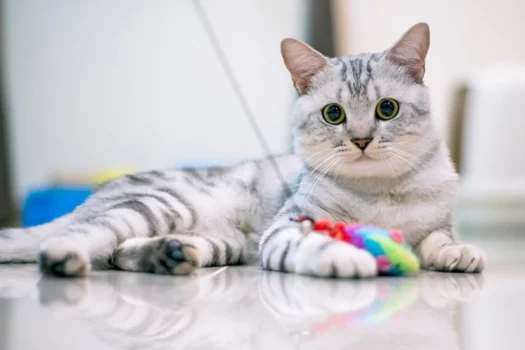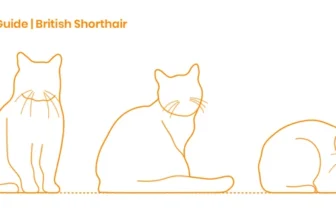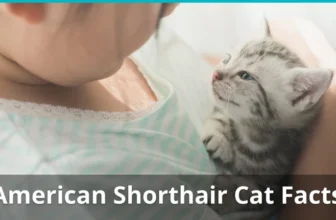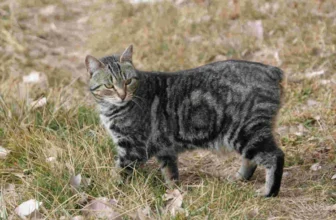Introduction
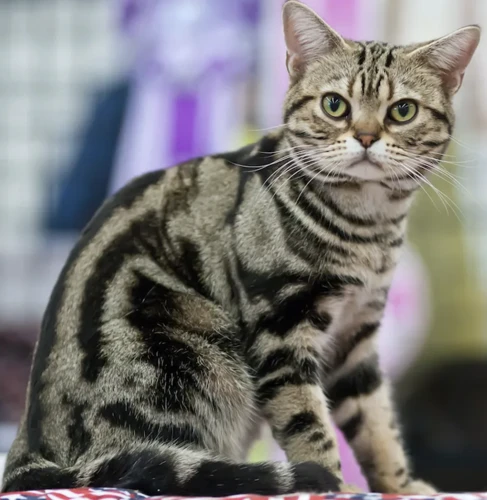
As a cat owner, you know that each feline has a unique personality and temperament. It takes time, patience, and the right training techniques to help your American Shorthair cat grow into a well-behaved feline companion. Whether you’re a new American Shorthair cat owner or want to improve your cat’s behavior, this guide provides step-by-step instructions and tips for training your cat’s temperament. From understanding your cat’s behavior to choosing the right tools and advanced training techniques, you’ll learn everything you need to know to train your American Shorthair cat effectively. So, let’s dive in!
About American Shorthair Cats
American Shorthair Cats:
American Shorthair cats are one of the most beloved cat breeds in America. These cats are known for their playful, friendly, and calm personalities. American Shorthair cats have a muscular and powerful body with a short coat that comes in various colors and patterns. This makes them a popular choice for cat lovers who want a low-maintenance pet that is also easy to train. Let’s take a closer look at the personality traits and characteristics of the American Shorthair cat.
| Traits | Description |
|---|---|
| Personality | American Shorthair cats are known for being playful, affectionate, and easy to train. They have a laid-back temperament and are friendly towards their owners and other pets. |
| Appearance | American Shorthair cats have muscular and powerful bodies with short, thick coats. They come in various colors and patterns, with the classic silver tabby being the most popular. |
| Health | American Shorthair cats are generally healthy, with a lifespan of around 15 years. However, they may be prone to certain health issues like obesity and dental problems. |
| Compatibility with other pets | American Shorthair cats are generally friendly and get along well with other pets like dogs and other cats. However, it is important to introduce them to other animals slowly and carefully. |
In general, American Shorthair cats make great pets due to their friendly, playful, and calm personalities. They are also easy to care for and train, making them an ideal choice for first-time cat owners. If you want to learn more about the American Shorthair cat and its personality traits, check out this article.
Understanding Your American Shorthair’s Behaviour
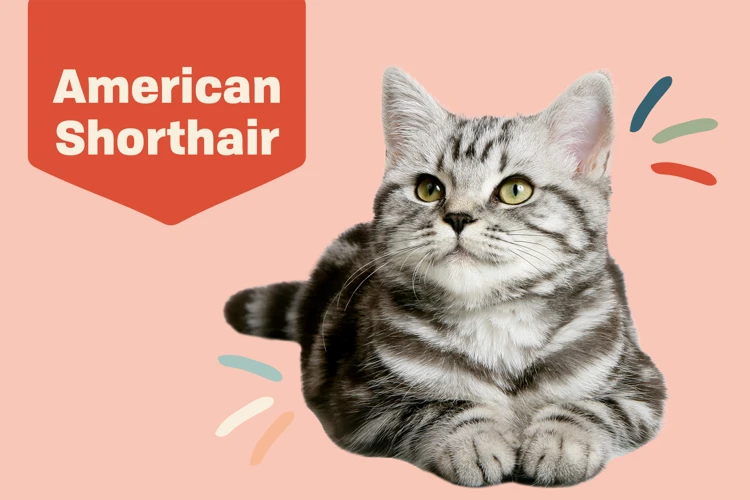
As a pet parent, it’s important to understand your American Shorthair’s behaviour in order to provide them with the proper care and training they need to thrive. American Shorthairs are known for their friendly and playful nature, and they can also get along well with other pets. They are typically calm and laid-back cats. However, like any pet, they may exhibit certain behaviour issues that need to be addressed. Let’s take a closer look at some common behaviour issues and how to understand your American Shorthair’s body language.
Common Behaviour Issues
As with any animal, American Shorthair Cats have their own unique personalities and behaviors that their owners should be aware of. Here are some of the common behavioral issues that American Shorthair Cat owners might encounter:
- Aggression: Some American Shorthair Cats may show signs of aggression towards other animals or people. This could be due to feeling threatened or territorial. If your cat is exhibiting aggressive behavior, it’s important to seek the help of a professional animal behaviorist.
- Scratching: As natural scratchers, American Shorthair Cats may scratch furniture or other household items without proper training. Providing a scratching post and redirecting their behavior towards it can help prevent damage to your belongings.
- Separation anxiety: American Shorthair Cats can become very attached to their owners and may suffer from separation anxiety when left alone. This could result in behaviors such as excessive meowing, destructive scratching, and house soiling.
- Fearfulness: American Shorthair Cats may become fearful of new people or experiences. This can manifest in behaviors such as hiding, hissing, or even aggressive behavior. Proper socialization techniques can help prevent fearfulness in cats.
- Unwanted marking: American Shorthair Cats may engage in urine marking behavior, particularly if they are not spayed or neutered. This behavior can be prevented through timely spaying or neutering and proper training.
It’s important for American Shorthair Cat owners to be aware of these common issues and take steps to prevent or address them. Proper training and socialization techniques can go a long way in raising a healthy and happy cat. If you want to read more about how your American Shorthair Cat gets along with other pets, you can check out our article “Do American Shorthair Cats Get Along With Other Pets?”.
Behavioural Clues – Ears, Tail & Body Language
Observing your American Shorthair’s body language is crucial for understanding their feelings and behavior. Here are some behavioral clues based on their ears, tail, and body language that can help you understand how your feline friend is feeling:
Ears:
– Forward-facing ears indicate that your cat is alert, curious, and possibly happy.
– Flat ears pressed against the head show that your cat is scared, anxious, or angry.
– Ears turned to the side mean that your cat is feeling relaxed or content.
Tail:
– A tail held high and straight up indicates that your cat is feeling confident, happy, and excited.
– A tail that is puffed up or bristled means that your cat is frightened, threatened, or aggressive.
– A tail tucked between the legs signals that your cat is fearful or anxious.
Body Language:
– Arching their back with fur standing on end means that your cat feels threatened or aggressive.
– Rolling over on their back with their belly exposed means that your cat is relaxed and ready to play.
– Stiff, tense body posture accompanied by dilated pupils shows that your cat is feeling threatened or anxious.
By understanding your American Shorthair’s behavioral clues, you can adjust your behavior and communication with them accordingly. A relaxed and comfortable cat is more receptive to training and will make training easier for both you and your cat. Keep a close eye on your cat’s body language to ensure they are happy, healthy, and safe.
Training Essentials
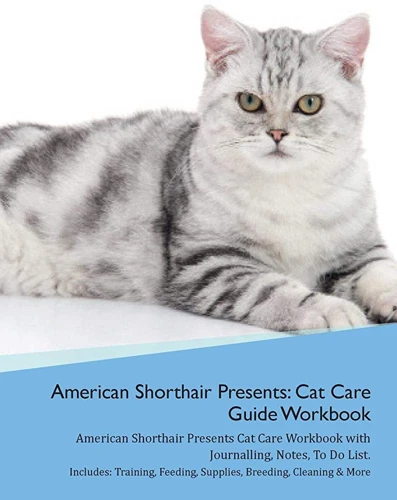
When it comes to training your American Shorthair’s temperament, there are some essential components that should be considered. These training essentials will provide a solid foundation for your cat to build on, allowing them to develop good habits and behaviors. By focusing on reward-based training, effective communication, and choosing the right tools, you can ensure that your American Shorthair is set up for success in their training journey. Let’s take a closer look at each of these training essentials and how they can strengthen your cat’s training progress.
Reward-Based Training
Reward-based training is widely considered to be one of the most effective ways to train cats, including American Shorthairs. This approach involves using positive reinforcement to encourage desired behavior rather than punishment or negative reinforcement. Here are some key points to keep in mind when using reward-based training for your American Shorthair’s temperament:
- Use treats wisely: Rewards should be used strategically to reinforce good behavior. Treats should be small and healthy, like freeze-dried meat or bits of cooked chicken.
- Timing is key: Treats should be given immediately after your cat performs the desired behavior to effectively reinforce it.
- Be consistent: Use consistent verbal cues and rewards for specific behaviors to ensure that your cat understands what you want them to do.
- Adjust expectations: Be realistic about your cat’s abilities and adjust training goals accordingly. It’s important not to push your cat too hard, or they may become frustrated and lose interest in training altogether.
- Monitor progress: Keep track of your cat’s progress over time. If they seem to be struggling with a particular behavior, adjust your training strategy accordingly.
Remember, every cat is different, and what works for one may not work for another. As you train your American Shorthair’s temperament, keep an open mind and be willing to adjust your approach as needed. With patience and persistence, you can help your cat become a well-behaved and happy member of your family.
Effective Communication
Effective communication is crucial in training your American Shorthair cat’s temperament. Just like with any other animal, cats respond better to positive reinforcement than punishment. It’s important to communicate with your cat in ways that they understand.
One way to communicate effectively with your cat is through body language. Studies show that cats can understand some of our body movements, such as pointing, nodding, and waving. However, it’s important to note that cats also have their own unique body language which represents their feelings. Here are some common cat body language cues to look out for:
| Cat Behaviour | Meaning |
|---|---|
| Purring | Contentment or happiness |
| Hissing, growling or spitting | Anger or fear |
| Arched back, raised fur, and ears flat | Feeling threatened or frightened |
| Tail held high and twitching | Excitement or anticipation |
Reward-based training is also an effective communication tool in training your American Shorthair’s temperament. This training involves rewarding good behaviour, while ignoring or redirecting bad behaviour. When your cat performs a desirable behaviour, such as using the scratching post instead of furniture, reward them with treats, praise, or attention. Conversely, when they exhibit undesired behaviour, like scratching the furniture, simply ignore them or redirect their attention to an appropriate behaviour like playing with toys or using their scratching post.
Lastly, tone of voice is also an important aspect of communication when training your cat’s temperament. Use a soft, calming voice when praising them for good behaviour and a stern voice when redirecting their attention away from undesirable behaviour. This will help them associate certain tones of voice with certain behaviours.
Effective communication plays a critical role in training your American Shorthair’s temperament. Understanding your cat’s body language, using reward-based training, and using an appropriate tone of voice will all help to create a deeper level of communication and understanding between you and your feline companion.
Choosing The Right Tools
When it comes to training your American Shorthair cat, choosing the right tools can make all the difference. Here are some options to consider:
| Tool | Pros | Cons |
|---|---|---|
| Clicker | Effective for marking desired behavior, easy to use, works well for positive reinforcement training. | May be difficult to synchronize with treat delivery, some cats may not respond well to the click sound. |
| Target Stick | Can be used for precision training, helps cats to easily understand what is expected of them. | May be difficult to use with shy or fearful cats who are not used to being touched with a stick. |
| Treats | Effective for positive reinforcement training, often highly motivating for cats. | May lead to overfeeding or weight gain if used inappropriately, not effective for cats who are not food motivated. |
| Scratching Post | Encourages appropriate scratching behavior, can be a great outlet for natural behavior. | May not be effective if not introduced early enough, may not be preferred by cats who prefer other scratching surfaces. |
It is important to consider your cat’s individual preferences and personality when selecting training tools. What works well for one cat may not work for another. Remember to always use positive reinforcement techniques and avoid using tools or techniques that may cause fear or anxiety in your cat. With patience and persistence, you can successfully train your American Shorthair cat’s temperament and strengthen your bond with your feline friend.
Training Your American Shorthair Cat’s Temperament
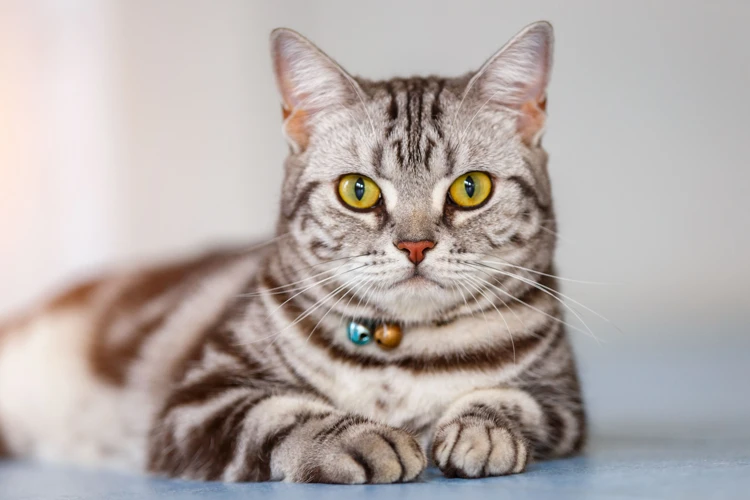
As a responsible American Shorthair Cat owner, it’s natural to want your feline friend to have a well-rounded temperament. Whether you’re looking to teach obedience, socialisation, or advanced tricks, training your pet can be an incredibly rewarding experience. With patience and persistence, you can take an active role in shaping your cat’s personality and behaviour. In the following sections, we’ll explore various training techniques that can aid in developing your American Shorthair’s temperament. Let’s dive in!
Training For Obedience
When it comes to training your American Shorthair cat’s temperament, obedience training is an essential part of the process. Obedience training teaches your cat to follow basic commands, making daily interactions easier and more enjoyable. Here are some key strategies for making obedience training a success:
| Consistency: | When training your American Shorthair cat for obedience, it’s important to be consistent. Use the same commands and rewards each time, and establish a regular training routine. |
| Reward-based training: | Positive reinforcement is one of the most effective ways to train your cat. Use treats, praise, and affection to reward your cat for following commands and behaving well. |
| Start small: | Begin with basic commands like “sit” and “stay,” and gradually move on to more complex tricks and behaviors. It’s important to build a strong foundation of obedience before moving on to more advanced training techniques. |
| Patience: | Obedience training takes time and patience. Don’t get frustrated if your cat doesn’t pick up a new command right away. Keep practicing, praising good behavior, and rewarding progress. |
| Avoid punishment: | Punishing your cat for bad behavior can be counterproductive and damage your relationship with your pet. Instead, focus on positive reinforcement and redirecting unwanted behaviors to more appropriate activities. |
With consistent, reward-based training, patience, and an understanding of your American Shorthair cat’s temperament, you can help your fluffy companion become a well-behaved and obedient pet.
Training For Socialisation
Socialization training is an essential step in creating a well-balanced and friendly American Shorthair Cat. Socializing your cat involves teaching them to tolerate and interact positively with people and other animals. It helps in avoiding unwanted behaviors such as aggression and shyness.
Step 1: Gradual Exposure
Start by gradually exposing your American Shorthair to new people, objects, and animals. Begin with a quiet room and a few people, allowing your cat to approach them at their own pace. Reward your cat’s good behavior with treats and positive reinforcement, but do not force them into uncomfortable situations.
Use the following table as a guide to gradual exposure:
| New Experience | Possible Reaction | Frequency of Exposure |
|---|---|---|
| New room | Nervousness, hiding | Twice a week |
| New person | Hissing or growling | Once a week |
| New animal | Hissing or growling | Once a week |
| Strange sound | Hiding or running away | As often as possible |
Step 2: Using Treats
Using treats is an effective way to teach your American Shorthair to behave positively in social situations. Have treats on hand during your socialization sessions, and reward your cat when they show good behavior, such as sitting calmly in the presence of new people or animals.
Step 3: Positive Reinforcement
Positive reinforcement involves rewarding your American Shorthair for good behavior with treats, affection, or verbal praise. The goal of positive reinforcement is to encourage your cat’s good behavior and help them associate socialization with positive experiences.
Step 4: Gradually Increase Difficulty
Gradually increase the difficulty of your socialization sessions by exposing your American Shorthair to more challenging situations. This could include taking your cat on a walk with a harness or introducing them to a new animal.
Remember, socialization is an ongoing process. Continue to expose your American Shorthair to new people and animals regularly to reinforce positive social behaviors. With patience and persistence, your cat will be well-socialized and a joy to be around.
Advanced Training Techniques
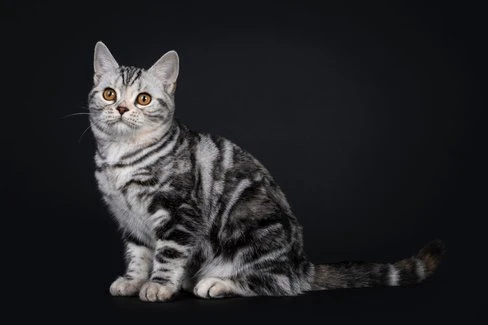
Congratulations on making it to the advanced training techniques part of the article! If you’re ready to take your American Shorthair Cat’s training to the next level and challenge both yourself and your feline friend, then keep reading. The following training techniques will require more time, patience, and effort but the payoff will be worth it. Don’t be afraid to try new things and get creative with your training approach. Let’s explore some advanced techniques that can help your American Shorthair Cat learn even more skills and behaviors.
Clicker Training
Clicker training is a positive reinforcement technique that involves a clicker and treats to train your American Shorthair cat. The clicker makes a distinct sound that lets your cat know that they’ve done the right thing and will be rewarded with a treat. This is an effective training method that can be used for many types of training, including teaching tricks and improving obedience.
The Benefits of Clicker Training
Clicker training is a powerful technique that offers many benefits for training your American Shorthair cat. Some of the key benefits include:
| Benefits of Clicker Training |
| • Faster learning |
| • More precise communication |
| • Positive reinforcement |
| • Increased bond with your cat |
How to Clicker Train Your American Shorthair Cat
Clicker training is a simple and effective way to train your American Shorthair cat. Here are the steps to follow:
- Get a clicker and some treats that your cat loves.
- Start by clicking the clicker and immediately giving your cat a treat. This will help your cat associate the sound of the clicker with a reward.
- Repeat this process several times until your cat has made the association between the sound of the clicker and the reward.
- Once your cat understands the sound of the clicker, you can start using it to shape your cat’s behavior.
- Click the clicker when your cat does something you like, such as sitting or coming to you. Immediately give your cat a treat to reinforce the behavior.
- Repeat this process, gradually adding more complex behaviors until your cat has mastered the desired behavior.
Final Thoughts
Clicker training is a powerful and effective way to train your American Shorthair cat. It’s a positive reinforcement technique that offers many benefits, including faster learning and more precise communication. By following these simple steps, you can train your cat to perform many types of behaviors, from basic obedience to advanced tricks. The key is to be patient, consistent, and to always reward your cat for their desired behaviors.
Target Training
Target training is a fun and effective way to train your American Shorthair cat. Essentially, it involves teaching your cat to touch its nose to a specific target (such as a stick or your hand) on command. This can help improve their focus and mental agility, as well as provide them with a sense of accomplishment.
The Basics of Target Training
To get started with target training, you’ll need a target object (such as a stick or a target mat) and some treats that your cat loves. Here’s a step-by-step guide to target training:
- Hold the target object in front of your cat’s nose.
- When your cat sniffs the object, say “touch” and give them a treat.
- Repeat this several times until your cat begins to understand the association between the command and the action.
- Gradually move the target object away from your cat so that they have to take a step to touch it.
- As your cat becomes more comfortable with this, increase the distance between them and the target object.
- Eventually, you should be able to place the target object on the ground and have your cat walk over to touch it on command.
Advanced Target Training Techniques
Once your cat has mastered the basics of target training, you can move on to more advanced techniques. One option is to teach your cat to touch a specific target from a distance. You can also teach your cat to touch multiple targets in sequence, or to touch targets in response to different commands.
Tips for Success
To ensure that your target training sessions are successful and enjoyable for both you and your cat, be sure to follow these tips:
| Tips for Success with Target Training |
|---|
| Be patient. Target training takes time and practice to master. |
| Use high-value treats to motivate your cat. |
| Keep training sessions short and frequent. |
| Make sure your cat is in the right mood for training – if they’re not interested, it’s unlikely they’ll be receptive to learning. |
| End each training session on a positive note – even if your cat didn’t master a new skill, make sure to give them plenty of praise and rewards for trying. |
Target training can be a great way to bond with your American Shorthair cat while improving their cognitive and physical abilities. With patience and persistence, you’ll be amazed at what your cat can achieve!
Trick Training
Teaching your American Shorthair cat tricks is a great way to not only bond with your pet, but also keep them mentally stimulated and active. Through trick training, you can also reinforce good behavior and improve your cat’s agility. Here are some popular tricks you can teach your American Shorthair cat:
| Trick | Description |
|---|---|
| High Five | Teach your cat to raise their paw and touch your hand when you hold it out. |
| Roll Over | Teach your cat to roll over on their back when given a verbal cue or hand signal. |
| Jump Through a Hoop | Start with a small hoop and lure your cat through it with a treat. Gradually make the hoop bigger and raise it higher. |
| Spin | Use a treat to lure your cat into turning in a circle. Repeat until they start to do it on their own. |
| Fetch | Teach your cat to retrieve a small toy or ball and bring it back to you. |
When teaching tricks, be patient and use reward-based training. Start by breaking down the trick into small achievable steps, and use treats and positive reinforcement to encourage your cat. It’s important to stop training sessions before your cat gets tired or frustrated.
Don’t forget to also use verbal cues and hand signals consistently so your cat can understand what you’re asking of them. By practicing trick training regularly, you’ll not only have a well-behaved American Shorthair cat, but also a smart and entertaining one.
Training For Health & Safety
Ensuring your American Shorthair’s health and safety is of utmost importance as a pet owner. In this segment, we will explore various training techniques that will aid in creating a safe and healthy environment for your feline friend. From litter box training to recall training, we have got you covered with all the essential strategies. Let’s dive into the details and enhance the overall well-being of your beloved cat with these training tips.
Litter Box Training
Training your American Shorthair cat for litter box use is an essential aspect of cat ownership. A properly trained cat will always use the litter box for their toileting needs, saving you from the hassle of cleaning up messes around the house. Here are some steps you can follow for litter box training your American Shorthair cat:
- Choosing the Right Litter Box: First and foremost, you need to select the right litter box for your cat. Look for a box that is spacious enough for your American Shorthair cat to turn around and stretch. Also, ensure that the litter box is low enough for your cat to climb in and out easily.
- Choosing the Right Litter: Next, select the right type and quantity of litter for your cat. Most American Shorthair cats prefer clumping litter, but some may prefer non-clumping litter. Fill the litter box with around two to three inches of litter.
- Introducing Your Cat to the Litter Box: When you get a new American Shorthair cat, introduce them to the litter box immediately. Show them where the litter box is located and gently place them inside it. You can help them to dig around in the litter a little to get them used to it.
- Positive Reinforcement: Praise and treat your American Shorthair cat when they use the litter box. This positive reinforcement will teach your cat that the litter box is where they should pee and poop.
- Keep the Litter Box Clean: Make sure to keep the litter box clean by scooping out solid waste daily and changing the litter once a week. Cats are very clean animals, and they can refuse to use a dirty litter box.
- Don’t Punish Your Cat: Never punish your American Shorthair cat for toileting outside the litter box. Instead, try to identify the reason behind this behavior and address it. Punishment may lead to your cat becoming defensive, stressed, or scared, which can make the problem worse.
By following these steps, you can effectively train your American Shorthair cat to use the litter box consistently. If you encounter any problems or your cat is not responding, reach out to a professional trainer to seek assistance. Remember, patience and consistency are key when it comes to cat training!
Scratching Post Training
Training your American Shorthair cat to use a scratching post is a crucial part of teaching them appropriate behavior and preventing damage to your furniture and carpets. Here are some key factors to consider during the training process:
| Factor | Tips |
|---|---|
| Location | Place the scratching post in a prominent location where your cat spends a lot of time, such as near their food or sleeping area. |
| Size and Material | Make sure the scratching post is tall enough for your cat to fully stretch out and made of a material that they enjoy scratching, such as sisal or cardboard. |
| Praise and Rewards | When you see your cat using the scratching post, immediately praise them and offer a small treat. This positive reinforcement will encourage them to continue using the scratching post. |
| Deterrents | If you notice your cat scratching furniture or carpets, use deterrents such as double-sided sticky tape or citrus-scented sprays to redirect them towards the scratching post. |
| Patience and Consistency | Remember that training your cat to use a scratching post may take time and consistency. Be patient and consistent in your training methods, and avoid punishing them for inappropriate scratching. |
By following these tips and consistently training your American Shorthair cat to use a scratching post, you can help them develop appropriate scratching behavior and preserve the longevity of your furniture and carpets.
Recall Training
Recall training is an essential part of training your American Shorthair cat for their safety. It is a technique that is used to teach your cat to come when called. Follow these simple steps for effective recall training:
- Start Indoors: Begin practicing recall training indoors where there are less distractions. Use treats or toys to encourage your cat to come to you when you call them by their name.
- Practice Positive Reinforcement: Reward your cat with treats and praise each time they respond to your recall command. Use a positive tone of voice to make them feel happy and secure.
- Use Leash Training: Once your cat has mastered recall training indoors, it’s time to move outdoors. Always use a leash when you start recall training outdoors to ensure your cat stays safe and secure.
- Gradually Increase Distance: Start by calling your cat from a short distance and gradually increase the distance as they become more comfortable with recall training. Reward them each time they respond to your command.
- Avoid Punishment: Never punish your cat if they do not respond to your recall command. It will only create fear and anxiety, making it more difficult to train them effectively.
By implementing these techniques on a regular basis, you will be able to train your American Shorthair cat for their health and safety. Remember to always use positive reinforcement and be patient as it may take some time for your cat to grasp recall training. Consistency and patience are key to a successful recall training.
Conclusion
After learning about the American Shorthair’s temperament and behavior, as well as the training essentials, you should now have a better understanding of how to train your beloved feline friend. Remember to always use reward-based training, effective communication techniques, and the right tools for your cat’s individual needs.
When it comes to training your American Shorthair’s temperament, it is important to focus on both obedience and socialization. With obedience training, you can teach your cat basic commands such as “sit” or “stay,” making it easier to avoid unwanted behaviors. Socialization, on the other hand, will help your cat adjust to various environments and social situations, leading to better overall behavior and temperament.
In addition to basic training techniques, you can also use advanced training methods such as clicker and target training to further improve your cat’s behavior and make training more enjoyable. And don’t forget about the important training for health and safety, such as litter box and scratching post training, as well as recall training to ensure your cat comes back to you when called.
With patience, consistency, and a positive attitude, you can successfully train your American Shorthair’s temperament and behavior. This will ultimately lead to a happier, healthier, and more well-behaved feline companion for you to enjoy for years to come. So go ahead and start implementing these training techniques today and watch your cat’s temperament and behavior transform before your eyes! Remember, a well-trained cat is a happy cat.
Frequently Asked Questions
1. Can American Shorthair cats be trained?
Yes, American Shorthair cats can be trained. They are highly intelligent and learn quickly.
2. What kind of training works best for American Shorthair cats?
Reward-based training is the most effective method for training American Shorthair cats.
3. How do I reward my American Shorthair cat during training?
You can reward your American Shorthair cat with treats, praise, and playtime.
4. Is it necessary to use tools during cat training?
Using tools, such as clickers and target sticks, can make training easier, but they are not necessary.
5. How do I train my American Shorthair cat to use a scratching post?
Place the scratching post in an area your cat likes to scratch and reward your cat when they use it. You can also use a catnip spray to attract your cat to the scratching post.
6. Should I punish my American Shorthair cat during training?
No, punishment is not effective in cat training and can damage your relationship with your cat.
7. How do I train my American Shorthair cat to come when called?
Use a distinct command word and reward your cat with treats when they come to you. Practice in a quiet environment before gradually building up to noisier areas.
8. How do I stop my American Shorthair cat from scratching furniture?
Discourage your cat from scratching furniture by providing scratching posts and using deterrents, such as double-sided tape or citrus sprays. Praise and reward your cat when they use the scratching post instead of furniture.
9. How long does it take to train an American Shorthair cat?
The length of time it takes to train an American Shorthair cat depends on the individual cat and the training goals. Consistency and patience are key to successful training.
10. Is training my American Shorthair cat important?
Training your American Shorthair cat is important for their health, safety, and well-being, as well as strengthening the bond between you and your cat.

